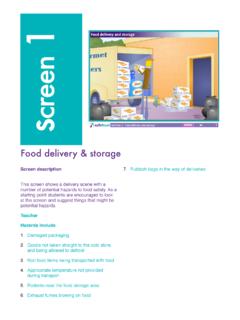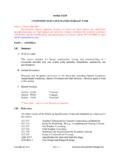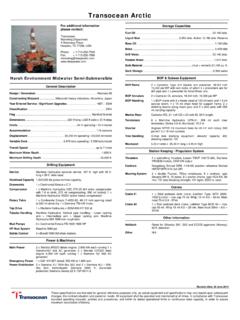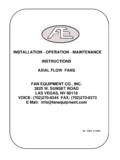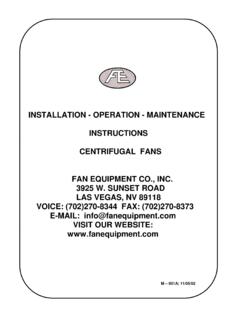Transcription of Stacking round timber, sawn timber and board …
1 1 of 5 pagesHealth and Safety ExecutiveHealth and Safety ExecutiveWoodworking Information Sheet No 2 (Revision 2)HSE information sheetStacking round timber , sawn timber and board materialsSafe working practicesIntroduction This information sheet contains practical guidance for employers, in particular managers and other dutyholders, on safe working practices for the safe Stacking and storage of logs, sawn timber and board materials. Employees may also find this information of use. The guidance applies to all sites, not just woodworking premises. It is based on consultation with the woodworking industry and the results of HSE-commissioned research into Stacking logs and sawn timber , and banding sawn timber ,2,3 Accident history Because timber and board materials are heavy, when accidents occur they tend to be serious.
2 Falling timber -based materials are one of the main causes of fatalities and serious accidents within the woodworking industry. Despite this, the risks posed by stacked timber are often not fully appreciated. Stacked timber is often given less attention than other more obvious risks such as those from machinery. A high proportion of falling timber -based material accidents involve propped up boards or doors. Injuries occur when the mass of boards or doors topple over as an attempt is made to withdraw a single board or door. What can you do to prevent these accidents? Your risk assessment4 made under the Management of Health and Safety at Work Regulations 1999 should cover the hazards and risks from Stacking and storage activities in your workplace. It should cover your employees and any others at risk, for example members of the public or contractors visiting your accidents could be prevented by devising and following safe working practices.
3 You should always make sure that: your Stacking /storage area is well organised with appropriate racking systems where necessary; everybody who is involved in Stacking is adequately trained and appropriately supervised; safe Stacking and unstacking procedures are always used supervisors should check regularly to make sure they are being followed. Consider the following information when making your risk assessment: Safe Stacking of logsThe most effective control measure to reduce the risk of injury from a log stack collapse is to locate log storage areas well away from pedestrian and vehicle routes. The use of a loader with grab attachments is the safest method of Stacking , de- Stacking and transporting logs as this avoids any need for workers to be on or near the stacks for slinging, see Figure 1. The height of the log stacks should be justified by the site risk assessment.
4 The height should however be limited to within the safe range of the grabber and take into account the cab position and the protection it has, see Figure 1. The maximum Stacking angles should be 45 but if it is not possible to keep stacks separate from workers then the angle should not exceed 35 . Wedges should be used to fix the logs and prevent them from rolling. Figure 1 Feeding a sawmill by grabber2 of 5 pagesHealth and Safety ExecutiveThe following factors will increase the risk of a stack collapsing: sloping ground causing logs to slide from the stack or roll down the slope; de-barked logs which are slippery, particularly if recently cut; logs stacked with their butt ends to one side of the stack so that the angle across the top of the stack causes logs to slide off, particularly if de-barked, see Figure 2.
5 Logs stacked on soft ground sinking on one side and becoming 2 Logs stacked with their butt ends to one side of the stackWhere any of these conditions are present, you should consider reducing the stack height or preventing movement of the logs by containment, either in bunkers or by using of sawn timber stacks Pack qualityYou need good quality packs to build a stable stack. Packing the same size of timber together to remove internal air space and using suitable sticks to bind layers of timber together will improve pack stability. Signs of broken or loose banding, lozenging, balling and internal collapse are all signs of poor practice when producing packs. Any out-of-shape or collapsing packs should be identified before being placed in a stack otherwise they will need to be safely removed from the stack and rebuilt.
6 Pack quality, particularly internal stability, can deteriorate each time they are transported so try to keep this to a minimum. Stack/pack accessPacks sometimes contain timber of varying length, known as truck bundled . These can provide footholds for climbing the stack, a practice which should be prohibited. Protruding timber can also be a danger to people or vehicles. If access to the top of a stack is required then it should be done safely. If no appropriate plant is available then you can use a secured or footed ladder provided the stack has been checked for stability and the area has been coned off. Any de- Stacking should be carried out from the top down, tier by tier, taking care to maintain stability and check for any signs of movement. Stacks should not be allowed to lean on each other, as during de- Stacking , forces will be exerted on the adjacent stack(s) and may cause a a stack is damaged and becomes unstable then it will need to be rebuilt.
7 To do this safely you should follow these guidelines: Before unstacking, examine the stack to see how it was constructed and to check for signs of instability or faults such as broken bands, bearers or sticks, and pack balling. It is important to identify any packs which are bridging other stacks or packs. Take down packs tier by tier. Move only one at a time. Do not leave isolated single stacks. Do not remove individual pieces of timber from packs until they are on the ground and the working area is safe. If you need access to the top of the stack do so safely, as detailed above. It should not be necessary to work at height directly on top of the a stack s initial examination it may be identified that it cannot be taken down safely by hand. A safer option may therefore be to effectively segregate the area and push the stack over with a suitable item of plant.
8 If this option is chosen then it should be strictly controlled and only followed when there is no other choice heights/qualityTo remain stable the packs must stay intact and not be subjected to any forces caused by wind or unstable ground conditions. As a general rule calculations have shown that stacks with a height-to-base ratio of up to 4:1 will remain stable where these factors are not present, provided that: the packs are banded to a high quality; they are on hard standing or on stable ground; they are located in an area where risks from impacts and other external forces are wind or ground conditions are a problem then the height-to-base ratio of the stack should be reduced to 3 of 5 pagesHealth and Safety Executive3:1 for an indoor stack and 2:1 if should be square or rectangular in cross section with centres of gravity directly over the centre of the bottom pack.
9 Place larger heavier packs at the bottom and pack placement should not cause any bridging between qualityPacks can become unstable if there is: the wrong type of banding; incorrect band tension; incorrect application (out of square).Your risk assessment should also ensure that the banding has a tensile strength that is appropriate for the dimensions and weight of the pack it is used on. See research document Banding of sawn timber packs3 for guidance on banding material suitability and general advice on the banding of timber packs. Banding should be in good condition and placed as close as possible to the columns of sticks within the pack, see Figure 3. Regular checks should identify and replace any damaged bands, clips or buckles. If this requires the removal of a pack from a stack, then do so safely. Eye protection should also be used when any banding material is cut and any risk of falling timber or pack collapse after the band has been cut must also be controlled.
10 Recurring problems should result in a review of banding conditionsStorage areas should ideally be flat, with any slope not exceeding 2 (a slight slope along the length of the stack will allow water to drain off). Concrete, asphalt and hard standing are the best ground for stacks. The ground surface should be strong enough to avoid cracking or breaking up under load or with wear and be well and separating sticksUse bearers and separating sticks that are square or rectangular in section, uniform, and in good condition. Those with a rectangular section are likely to be more stable provided they are laid on their wider cross-section. There should also be a good supply of them as often unsuitable ones end up being used. The bearer s cross-section should allow access for the forks of a fork-lift truck (FLT) or side loader.










